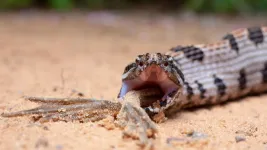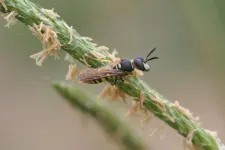Surprising ionic and flow behaviors with functionalized nanochannels
UMD engineering research team demonstrates overscreening, flow reversal in nanosystems
2021-04-19
(Press-News.org) Nanochannels have important applications in biomedicine, sensing, and many other fields. Though engineers working in the field of nanotechnology have been fabricating these tiny, tube-like structures for years, much remains unknown about their properties and behavior.
Now, University of Maryland mechanical engineering associate professor Siddhartha Das and a group of his Ph.D. students have published surprising new findings in the journal ACS Nano. Using atomic-level simulations, Das and his team were able to demonstrate that charge properties as well as charge-induced fluid flow within a functionalized nanochannel does not always behave as expected.
"We've discovered a new context for nanochannels functionalized by grafting their inner walls with charged polymer molecules (also known as polyelectrolytes or PEs)," Das said, referring to the process of grafting polymers or other substances onto the nanochannel in order to cause it to function in a certain way. "The functionalization of nanochannels is not new. But we've come up with a paradigm shift in terms of understanding the behavior and properties of such systems in the context of their charge properties and their ability to regulate fluid flow.
"For example," Das said, "we've discovered a new type of flow behavior in such functionalized nanochannels; by increasing the magnitude of the electric field applied to a nanochannel, the direction of this electric-field-driven flow (often known as electroosmotic flow) can be reversed."
The paper by Das and his students details three specific discoveries. Firstly, they showed that, when polyelectrolytes (PEs) are grafted in the form of a layer on the inner wall of the nanochannel, this PE layer will, under certain conditions, undergo a surprising reversal of electrical charge. Normally, if negative PE molecules have been attached to the nanochannel, the PE layer nearby should have a net negative charge. Das and his students, however, identified situations in which the charge becomes inverted and the net charge within the layer is positive due to the attraction of more number of positive ions (than needed to screen the charge of the PE layer) within the layer--this phenomenon is known as "overscreening."
The team then investigated how this overscreening affects the external electric field driven flow (known as the electroosmotic or EOS flow) within the nanochannel. They found, surprisingly, that in such situations the flow is driven by ions having the same charge as the Pes grafted onto the channel walls; thus, a negatively charged polymer creates a net positive field in its vicinity, but the flow is driven by the negative ions.
"We call this 'co-ion driven electro-osmosis,' and our paper marks the first time this phenomenon has been identified," Das said.
Finally, the team demonstrated the unexpected results of ramping up the magnitude of the electric field: the PE molecules attached to the nanochannel become deformed, and the ions that caused the instance of overscreening start to escape from the PE layer. This causes the overscreening to stop, and also reverses the direction of flow in the channel: if it was moving left to right, for instance, it switches to right-left. "No one predicted this," Das said.
The findings are significant, Das said, because much of the interest in nanochannels relates from their ability to transport molecules. "Since flow is so important, a new discovery in this area allows us to build on our understanding of how nanochannels work and what we can do with them," Das said. "There are other methods of reversing flow, but until now it was not known that we can accomplish this by increasing field strength."
INFORMATION:
A member of the UMD mechanical engineering faculty since 2014, Das is a Fellow of the Institute of Physics and also a Fellow of the Royal Society of Chemistry. The Ph.D. students who co-authored the ACS Nano paper are Turash Haque Pial, Harnoor Singh Sachar, and Parth Rakesh Desai.
The A. James Clark School of Engineering at the University of Maryland serves as the catalyst for high-quality research, innovation, and learning, delivering on a promise that all graduates will leave ready to impact the Grand Challenges of the 21st century. The Clark School is dedicated to leading and transforming the engineering discipline and profession, to accelerating entrepreneurship, and to transforming research and learning activities into new innovations that benefit millions. Visit us online at eng.umd.edu.
[Attachments] See images for this press release:

ELSE PRESS RELEASES FROM THIS DATE:
2021-04-19
One of the marks of a successful idea in science is how quickly it can develop and evolve. In the case of the Anthropocene, the conceptual evolution has taken place with extraordinary speed. The strikingly influential hypothesis launched by the late Nobel laureate Paul Crutzen (Obituary, 24th Feb 2021) in 2000, was that the actions of an industrialised humanity has impacted the Earth so greatly as to trigger a new geological epoch. Originally developed within the Earth System science community in charting global environmental change, the Anthropocene then began ...
2021-04-19
April 19, 2021 -- Ensuring COVID-19 vaccine access for refugee and displaced populations, and addressing health inequities, is vital for an effective pandemic response. Yet, vaccine allocation and distribution has been neither equitable nor inclusive, despite that global leaders have stressed this as a critical aspect to globally overcoming the pandemic, according to a paper published by Columbia University Mailman School of Public Health. Read "Leave No-one Behind: Ensuring Access to COVID-19 vaccines for Refugee and Displaced Populations" in the journal Nature Medicine.
As of April 1st, high and upper-middle-income countries received 86 percent of the vaccine doses delivered worldwide, while ...
2021-04-19
Tools that allow neuroscientists to record and quantify functional activity within the living brain are in great demand. Traditionally, researchers have used techniques such as functional magnetic resonance imaging, but this method cannot record neural activity with high spatial resolution or in moving subjects. In recent years, a technology called optogenetics has shown considerable success in recording neural activity from animals in real time with single neuron resolution. Optogenetic tools use light to control neurons and record signals in tissues that are genetically modified ...
2021-04-19
A group of scientists have just made a key discovery that could prevent and eradicate immune responses that lead to treatment failure in about one-third of people with severe hemophilia A.
Hemophilia is the most common severe inherited bleeding disorder in men. The disease affects 1 in 10,000 males worldwide and results from deficiency of blood clotting factor VIII (FVIII). Both children and adults with hemophilia A (80 percent of all hemophilia) receive treatment that involves infusing FVIII protein into the bloodstream. However, about 30 percent ...
2021-04-19
Our planet's worst mass extinction event happened 252 million years ago when massive volcanic eruptions caused catastrophic climate change. The vast majority of animal species went extinct, and when the dust settled, the planet entered the early days of the Age of Dinosaurs. Scientists are still learning about the patterns of which animals went extinct and which ones survived, and why. In a new study in PNAS, researchers found that while extinctions happened rapidly in the oceans, life on land underwent a longer, more drawn-out period of extinctions.
"People assumed that because the marine extinction happened over a short period of time, life on land should have followed the same pattern, but we found that the marine extinction ...
2021-04-19
Professor Nicole Boivin, Director of the Department of Archaeology at the Max Planck Institute for the Science of Human History in Jena, Germany, is part of an international initiative to examine the implications of past land use for contemporary conservation efforts.
The multi-disciplinary team, which includes archaeologists, ecologists, anthropologists and conservation managers, has reconstructed ancient population and land use to show that already by 12,000 years ago, humans had re-shaped much of the terrestrial biosphere.
Their data challenge the idea that conservation ...
2021-04-19
New research published today in the Proceedings of the National Academy of Sciences (PNAS) shows that land use by human societies has reshaped ecology across most of Earth's land for at least 12,000 years. The research team, from over ten institutions around the world, revealed that the main cause of the current biodiversity crisis is not human destruction of uninhabited wildlands, but rather the appropriation, colonization, and intensified use of lands previously managed sustainably.
The new data overturn earlier reconstructions of global land use history, some of which indicated that most of Earth's land was uninhabited even as recently as 1500 CE. Further, ...
2021-04-19
Diversity in diet plays a role in the complexity of venom in pit vipers such as rattlesnakes, copperheads and cottonmouths.
But new collaborative research by Clemson University scientists found the number of prey species a snake ate did not drive venom complexity. Rather, it was how far apart the prey species were from each other evolutionarily.
"It's not just diet that drives the variation in venom across snakes. It's the breadth of diet," said Christopher Parkinson, a professor in the College of Science's Department of Biological Sciences. "If a snake eats 20 different species of mammals, its venom will not be very complex. But if it eats a centipede, a frog, a bird and a mammal, it's going to have a highly complex venom because each component of that venom ...
2021-04-19
Antibiotics on the cocoon protect the offspring of beewolves, a group of digger wasps, from detrimental fungi. These protective substances are produced by symbiotic bacteria of the genus Streptomyces, which live in these insects. In a new study in PNAS, researchers from the Max Planck Institute for Chemical Ecology and the University of Mainz, together with an international team, showed that these beneficial bacteria are losing genetic material that is no longer needed. The genome of these bacteria is of great interest for understanding the process of genome erosion and elucidating how the cooperation and the mutual benefit between bacteria and their host insects have evolved over long periods of time (PNAS, doi: 10.1073/pnas.2023047118, ...
2021-04-19
Police violence against Black Americans is shamefully common in the United States and devastates communities. For incidents that get widespread media exposure, a collective trauma is felt across the nation, especially for Black individuals. Research supports that experiencing racism even vicariously can harm the mental and physical health of others of the same racial group, yet its effect on a population level is unclear.
A new study analyzed how highly publicized acts of racial violence impacted the mental health of Black Americans in the U.S. The authors identified 49 incidents that occurred between 2013 and 2017, including police killings of Black individuals, hate-crime murders and decisions not to indict or convict the officers involved. The researchers measured ...
LAST 30 PRESS RELEASES:
[Press-News.org] Surprising ionic and flow behaviors with functionalized nanochannels
UMD engineering research team demonstrates overscreening, flow reversal in nanosystems





